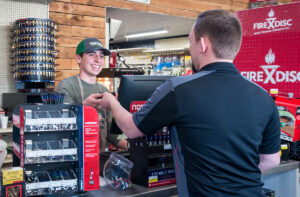Conquer the Retail Amazon with a Unique Shopping Experience
The Amazon is one of the world’s largest, most foreboding jungles encompassing roughly 7 million square kilometers and the better part of nine nations. The retail version is just as impressive but in other ways. Amazon.com grossed $230 billion in sales in 2018 which would make it the 51st richest country in the world. It sells over 12 million products and it moved over 175 million items on Prime Day 2019. And it has approximately 206 million visitors monthly. Started in 1994 in a Seattle garage, the company has redefined how retail works. As imposing as it is, small businesses can succeed in the new retail jungle by focusing on their in-store shopping experience.
The first thing any retailer needs to know is where they can and cannot compete with the online and big-box giants.
Don’t Go There
Amazon and big boxes like Walmart, Home Depot, Best Buy and others make billions by offering low prices and huge selections. Shoot, many of them use those words in their company slogans:
“Low prices guaranteed” and “More savings. More doing.” Home Depot
“Save money. Live better” and for the 19 previous years “Always low prices. Always.” Walmart
“Expect more. Pay less.” Target
“Do it right for less.” Lowe’s
So, it’s best not to try to go head-to-head on price and selection with companies that net billions in revenue each year.
And even if their size and selection aren’t enough to attract customers like flies, many of them offer a price-matching guarantee as an added attraction. Walmart, Target, Best Buy, Home Depot, Lowe’s and Staples are among the big-box and online price-matchers.
Needless to say, trying to beat these retail Goliaths at their own game isn’t a wise game plan.
Win with Charm, Style, Tech
It’s always best to go with your strengths. So, the goal of every small, independent business should be to provide memorable shopping experiences that the big-box stores and websites just can’t duplicate. The winning recipe is equal parts of unique products and friendly, personalized customer service, with a dash of technology. Tech is necessary in today’s marketplace to enhance both products and services to make a shopping experience truly memorable and turn shoppers into loyal return customers.
Admit it. How many times have you been into a big-box store and felt like you were all alone on a quest to find what you need? Like Indiana Jones, you venture into “The Temple of Doom” only to leave frustrated and empty-handed, knowing the store probably had what you wanted if you could have gotten some help finding it. Poor customer service is what drives people to shop online in the first place and it’s a weakness many of the big-box stores are working feverishly to address.
Friendly, personalized customer service is an advantage many independent retailers have over the cavernous big boxes and robotic e-commerce giants. That hometown advantage can be further enhanced by utilizing modern retail platforms that help store owners and associates get to know their customers better. Just like Amazon and Google, small stores can use retail technology that features shopper loyalty or rewards programs to learn what products their customers need or want.
Data gathered from rewards programs allows businesses to create personalized offers that can keep those customers coming back for more. RepeatRewards is an example of a loyalty program available to independent businesses that can be operated through their retail platforms. It offers all the same bells and whistles the big-box or online rewards programs have.
Make it Personal
“If you want to be an entrepreneur, the most important thing is to be customer–obsessed. Don’t satisfy your customers, figure out how to absolutely delight them. That is the number one thing.” Jeff Bezos
It might be surprising to some, but the Amazon founder, president and CEO provided the philosophy above. For all its size, automation and imposing corporate identity, Amazon uses all the data it gathers from customers to personalize its shopping experience and customize its offerings. Amazon Prime members regularly receive discounts on food, clothing and more, along with special offers that include free streaming music, movies, games and television. These discounts and offers are all crafted by their customers’ past purchases and search histories.
This kind of personalization, along with its delivery services, (more on that later) has kept Amazon ranked in the top 10 in customer satisfaction for the past 10 years. In fact, from 2016 to 2018, the company topped the independent poll. Trader Joe’s and Costco claimed the top spot in 2019.
Independent businesses can have the same impact by combining friendly in-person customer service and a little technology. Even though online commerce is growing rapidly – Statista says 23% in 2018 – it still accounts for only about 12% in global retail sales. That means 80% to 90% of retail sales still happen in brick-and-mortar stores.
More research published in Retail Dive shows that 92% of respondents to a poll said the in-store shopping experience offers the highest satisfaction in purchasing options. Information like this makes it more important than ever for independent businesses to invest in improving their customer service and shopping experience.

How to Get Personal
Hire local staff. Finding and hiring knowledgeable, local people is one of the easiest ways to build a strong, loyal customer following. In smaller markets, residents know who and what stores to go to get quality information or products. Word-of-mouth advertising is priceless and satisfied customers will tell others of their experiences.
Spread the wealth. Independent businesses can support each other. Spending money locally supports your neighborhood. It can also create a network of business-to-business (B2B) clients that can return the investments.
Get involved in the community. There are many ways to do this. Whether it’s a hardware store offering free weekend classes on gardening or a do-it-yourself (DIY) project, volunteering labor or materials in a community cleanup project, or sponsoring youth activities, community outreach will earn you new customers.
Find Your Niche
Another way to attract new shoppers is to offer items they can’t find in your typical big box. Locally sourced products are often the easiest way to find a niche. Examples might be:
Local blacksmiths who do custom ironwork.
Craftsmen who make handmade knives or tools.
Carpenters who craft custom furniture.
Farmers who provide locally sourced food products like honey, cheese, plants, flowers and herbs.
Sometimes businesses can use their location to develop a niche.
In the historic California gold country town of Dunsmuir, Dunsmuir Hardware offers gold prospecting supplies. Pick and Shovel in Newport, Vermont capitalizes on the New England maple sugaring industry to sell tapping supplies. Taylor Do it Best Building Supply in Eastpoint, Florida stocks saltwater fishing gear. And the Ace Hardware store in Pocatello, Idaho capitalizes on its location near the Snake River to market and sell outdoor gear such as camping, hunting and fishing equipment.
Enhancing Your Customer Experience with Technology
The Price Waterhouse Coopers (PwC) and Kantar Retail’s study “Retailing 2020” predict:
Non-store sales – mobile and e-commerce – will drive retail growth.
Retailers will integrate sales efforts across physical, digital and media touchpoints.
In-store product merchandising will be more interactive for shoppers
Retailers will actively collect and utilize customer data gathered from sales transactions to personalize communication and offers.
So far, online retailers have had an advantage over brick-and-mortar stores in their ability to comb the internet and provide interactive customer content like price comparisons and product demonstration videos. That trend is changing, though. According to the 2019 Unified Commerce Survey from Boston Retail Partners (BRP), 34% of shoppers use their smartphones to research and compare products while shopping in stores.
Brick-and-mortar retailers can now offer the same services to their customers through digital retail platforms that feature integrations such as Ez-Ad. These apps allow store associates armed with smartphones to show customers real-time price comparisons, product demonstration videos and more. They also provide video content to in-store monitors creating dynamic digital signage.
Another way independent businesses can battle against e-commerce tech is by utilizing tools like Pointy, an easy-to-use retail application that lets small businesses place their products into localized Google searches right alongside behemoths such as Amazon, Wayfair and Overstock.
Delivering the Goods
Delivering the goods means more in retail today than having desirable products, friendly customer service and a nice store. Thanks to Amazon, it also means delivering products to homes and businesses.
“Globally speaking, same–day delivery is no longer just a concept. Instead, it’s the standard practice in many industries nowadays,” Nick Hartman, Marketing and Communications manager for Go People, writes on his company’s blog.
The “2018 Digital Commerce Benchmark Survey” from BRP, a retail management consulting firm, showed that 51% of retailers offered same-day delivery. Retailers who want to keep up with the competition should consider looking into local delivery options or take the do-it-yourself approach.
Brick-and-mortar retail stores have a hometown advantage when it comes to wooing local shoppers. With the right mix of products, customer service, and a little technology, conquering the retail Amazon is not as formidable as it may seem.
Brian Bullock
Author


